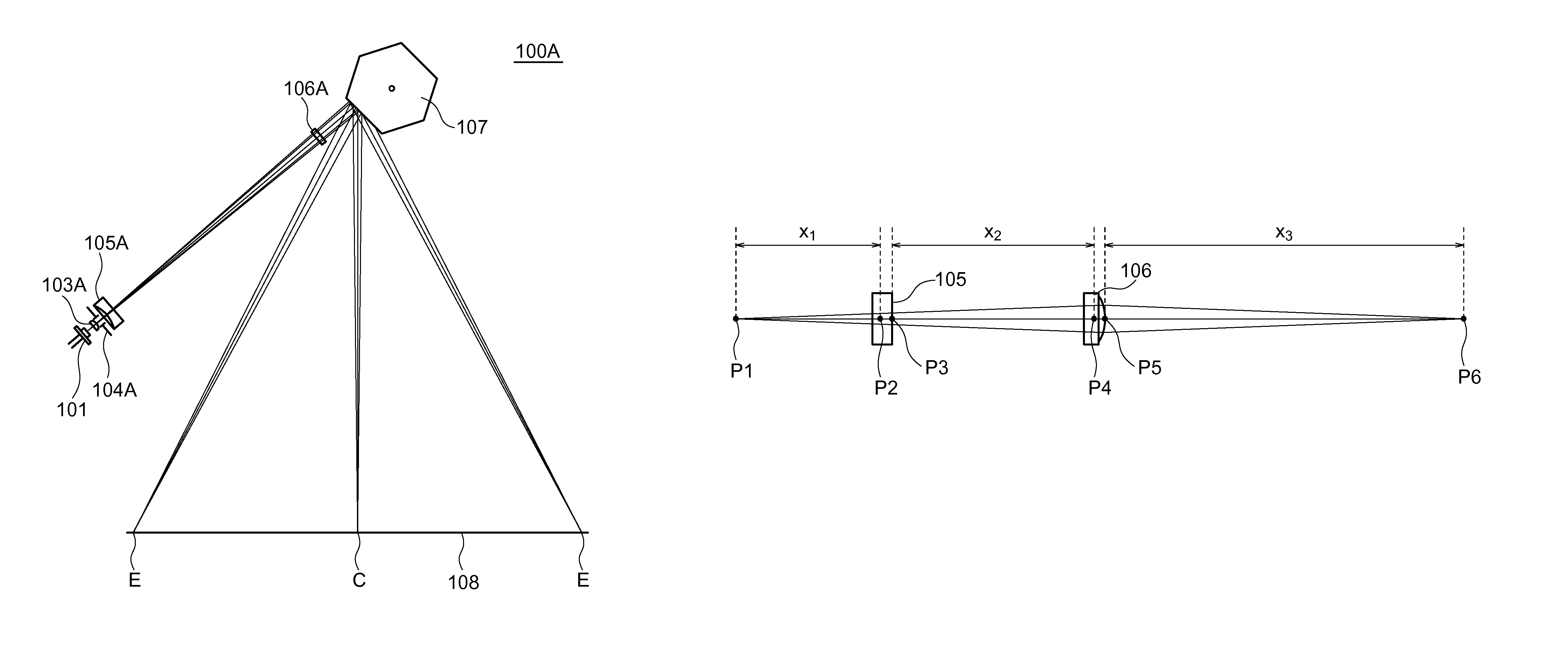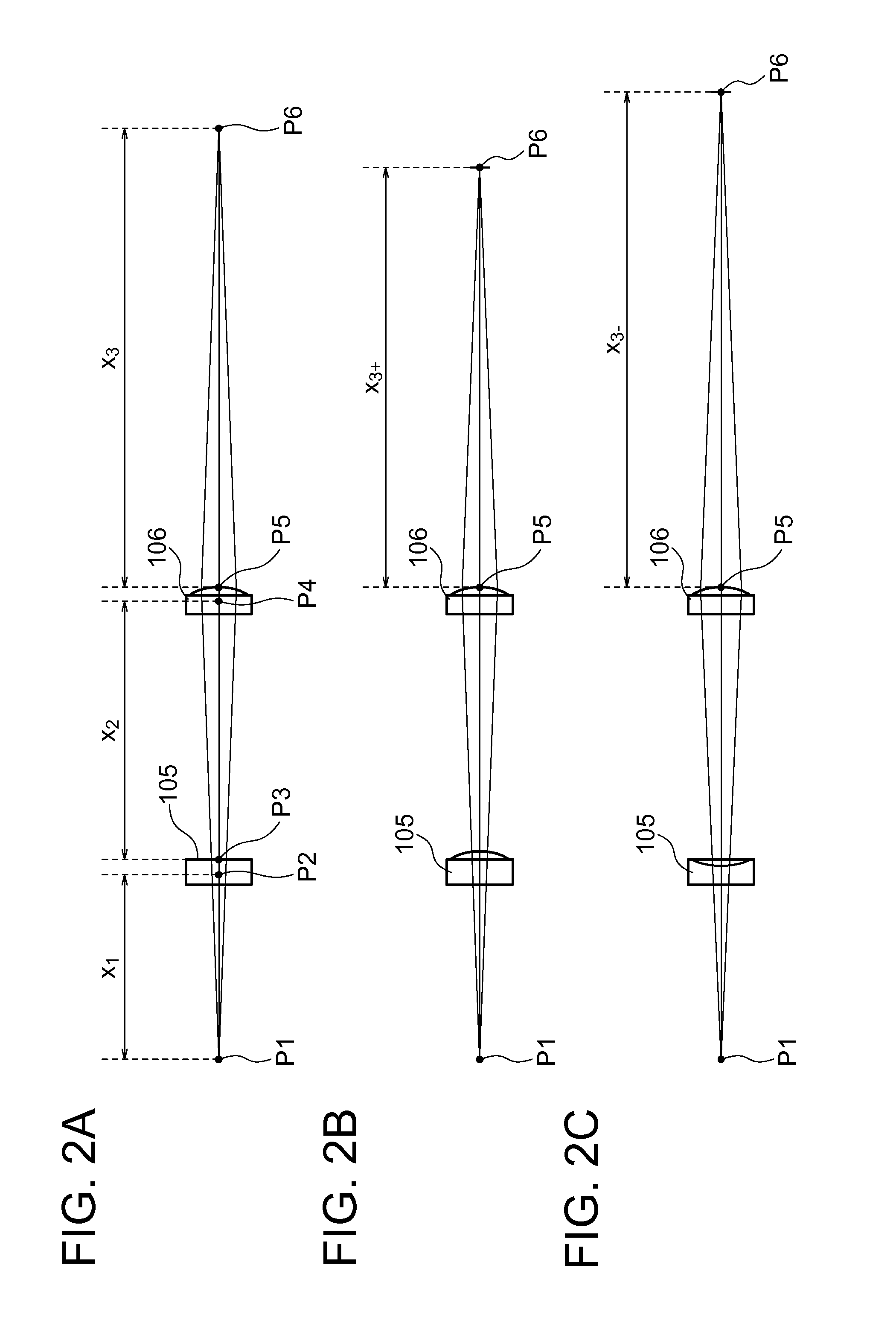Optical scanning system
a scanning system and optical technology, applied in the field of optical scanning systems, can solve the problems of deterioration of quality of drawing, high cost, and large space requirements of long-length imaging lenses, and achieve the effect of increasing the spot diameter
- Summary
- Abstract
- Description
- Claims
- Application Information
AI Technical Summary
Benefits of technology
Problems solved by technology
Method used
Image
Examples
example 1
[0071]FIG. 1 shows an arrangement of the optical scanning system 100A of Example 1. The optical scanning system 100A includes the condenser lens 103A, the aperture 104A, the variable-focus element 105A, the imaging lens 106A and the deflector 107 such as a polygon mirror. Light emitted by the laser diode light source 101, wavelength of which is 780 nm, is converted into a predetermined divergent beam by the condenser lens 103A, made to pass through the variable-focus element 105A and the imaging lens 106A and deflected by the deflector 107 such that the beam scans a light receiving surface 108 in the horizontal direction in FIG. 1. The variable-focus element 105A is controlled such that the beam constantly forms an image on the light receiving surface during the period of the scanning. In FIG. 1, the center of the scanning line on the light receiving surface 108 is represented as C and the both ends are represented as E.
[0072]Table 1 shows numerical data of the optical scanning syst...
example 2
[0081]FIG. 4 shows an arrangement of an optical scanning system 100B of Example 2. The optical scanning system 100B includes a condenser lens 103 B, an aperture 104B, an imaging lens 106B and a deflector 107 such as a polygon mirror. Light emitted by a laser diode light source 101, wavelength of which is 780 nm, is converted into a predetermined divergent beam by the condenser lens 103B, made to pass through the imaging lens 106B and deflected by the deflector 107 such that the beam scans a light receiving surface 108 in the horizontal direction in FIG. 4. The condenser lens 103B is made to move in the direction of the optical axis in a predetermined section in synchronization with the scanning caused by the deflector 107. Movement of the condenser lens 103B in the direction of the optical axis changes a position of an image of the beam along the optical path. The position of the condenser lens 103B is controlled such that the beam constantly forms an image on the light receiving su...
example 3
[0089]FIG. 5 shows an arrangement of an optical scanning system 100C of Example 3. The optical scanning system 100C includes a condenser lens 103C, an aperture 104C, a variable-focus element 105C, an imaging lens 106C and a deflector 107 such as a polygon mirror. Light emitted by a laser diode light source 101, wavelength of which is 780 nm, is converted into a predetermined divergent beam by the condenser lens 103C, made to pass through the variable-focus element 105C and deflected by the deflector 107 such that the beam scans a light receiving surface 108 in the horizontal direction in FIG. 5. Then, the beam passes through the imaging lens 106C. The variable-focus element 105C is controlled such that the beam constantly forms an image on the light receiving surface during the period of the scanning. In FIG. 5, the center of the scanning line on the light receiving surface 108 is represented as C and the both ends are represented as E.
[0090]Table 5 shows numerical data of the optic...
PUM
 Login to View More
Login to View More Abstract
Description
Claims
Application Information
 Login to View More
Login to View More - R&D
- Intellectual Property
- Life Sciences
- Materials
- Tech Scout
- Unparalleled Data Quality
- Higher Quality Content
- 60% Fewer Hallucinations
Browse by: Latest US Patents, China's latest patents, Technical Efficacy Thesaurus, Application Domain, Technology Topic, Popular Technical Reports.
© 2025 PatSnap. All rights reserved.Legal|Privacy policy|Modern Slavery Act Transparency Statement|Sitemap|About US| Contact US: help@patsnap.com



